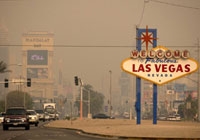Does The Combination of Sun, Geogrpahy, And Farming Cause Air Pollution?
Forbes came out with its list of "Most Polluted Citites" in the United States today.
There is something strange here:
First, all five of these areas are valleys. The cities all nestle up against mountains. Los Angeles' valley opens up onto the sea, but the Hollywood hills make it a real valley. In other words, there is nowhere for air to escape to but upward.The metro areas with the nation's poorest air quality
President Obama's recent proposal to open some areas along the eastern Gulf of Mexico, the Atlantic coastline and the north coast of Alaska to oil and natural gas drilling elicited praise from drilling advocates and oil companies as well as sharp criticism from environmental groups and citizens near the areas that might be affected.
The environmental impacts from doing so won't be felt for some time. What's affecting Americans today? Poor air quality. This matter often gets buried under more high-profile concerns like climate change, but it is particularly important as summer approaches because sunlight is a key ingredient in making harmful ozone, a ground level gas that contributes to urban smog and inflames the lungs, causing shortness of breath, wheezing and throat irritation.

Sunny areas like Los Angeles face the harmful effects of ozone year-round. In fact, the Los Angeles metro is named the country's worst for ozone by the American Lung Association's State of the Air 2010 report, released Wednesday. The ranking is worrisome for the city's residents because inhaling ozone is akin to "getting a sunburn on your airways," says Dr. Norman H. Edelman, the ALA's chief medical officer.

Other California metros didn't fare much better: Bakersfield, Visalia, Fresno and Sacramento round out the five worst regions for ozone. The problem is statewide because of both California's exposure to sunlight and a natural geography that allows pollution to hover rather than diffuse to other areas, says Janice Nolen, the ALA's assistant vice president for policy and advocacy.

The State of the Air report also ranks cities based on short-term and year-round particle pollution, which are caused by emissions of sulfur dioxide, carbon and nitrogen oxides. The short-term measure ranks metros by periodic spikes in airborne particles, and Bakersfield, Calif.; Fresno, Calif.; Pittsburgh; Los Angeles; and Birmingham, Ala., were, by this measure, found to have the country's five worst.

Some of these cities also show up in the rankings for year-round particle pollution, which measures the daily average level of airborne particles. The five worst areas are: Phoenix-Mesa-Scottsdale, Ariz.; Bakersfield, Calif.; Los Angeles; Visalia, Calif.; and Pittsburgh.
Behind The Numbers

State of the Air 2010 ranks metropolitan statistical areas and combined statistical areas based on data collected by the U.S. Environmental Protection Agency (EPA) between 2006 and 2008. Both the ozone and short-term particle pollution rankings are based on spikes in their daily measurements and were calculated using weighted averages; each level of the Air Quality index was given a numerical weight, and these values were then multiplied by the number of days each metro reached them. Contrarily, the year-round particle pollution rankings are based on the average daily airborne particle levels during the three years studied.

The ALA found that over 175 million Americans, or 58% of the population, live in counties with unhealthy levels of either ozone or particle pollution. Worse, almost 24 million people live in counties with unhealthy levels of ozone and both short-term and year-round particle pollution.

Poorer populations are especially vulnerable. "People in poverty often live near major highways, near sources of pollution," Nolen says.
5 Worst Cities For Ozone Pollution
1. Los Angeles-Long Beach-Riverside, Calif.
Total Population: 17,786,419
Pediatric Asthma: 442,040
Adult Asthma: 1,094,827
Chronic Bronchitis: 556,68
Emphysema: 200,3382. Bakersfield, Calif.
Total Population: 800,458
Pediatric Asthma: 22,479
Adult Asthma: 46,597
Chronic Bronchitis: 23,265
Emphysema: 7,7903. Visalia-Porterville, Calif.
Total Population: 426,276
Pediatric Asthma: 12,749
Adult Asthma: 24,202
Chronic Bronchitis: 12,169
Emphysema: 4,2494. Fresno-Madera, Calif.
Total Population: 1,057,486
Pediatric Asthma: 29,351
Adult Asthma: 62,100
Chronic Bronchitis: 31,280
Emphysema: 10,9655. Sacramento--Arden-Arcade--Yuba City, Calif.-NV
Total Population: 2,417,404
Pediatric Asthma: 55,670
Adult Asthma: 153,359
Chronic Bronchitis: 78,640
Emphysema: 29,653
Here is a map of California:

So, you can see, topographically, how these areas are climate traps.
Add to this the fact that three of the four chemicals being discussed here as "pollutants" are, indeed, known to be abundant elements in a healthy ecology; Ozone, Nitrogen Oxides, and Carbon.
Sulfur Dioxice, it is true, has no role in mammalian biology. And, I guess, what does not make us better will kill us. So, let's call Sulfur Dioxide a true pollutant.
But, carbon is the basic building block of human beings. Additionally, Carbon Dioxide is what we exhale, and it is what trees inhale.
Nitrogen is an important element of healthy soil, so it no surprise that, where there is healthy soil, there is also an abundance of nitrogen atoms which combine with oxygen atoms to create nitrogen oxides. During the day, there is more nitrous oxide and ozone, and during the night time there is more nitrogen dioxide.
And finally, on the subject of Ozone; it is said, by scientists to be good up high in the stratosphere, but not so good for humans. Too bad it is a naturally occurring element in sunny areas:
Strong sunlight and hot weather cause ground-level ozone to form in harmful concentrations in the air.So, we see that, if four of the five most polluted cities in the United States are mostly rural farm communities, and all five are valleys in the sun, then sunlight, and the warmth it provides must be the main culprit in "air pollution".
Maybe Obama can begin taxing the sun. After all, it is putting out more than it's share of light.


0 Comments:
Post a Comment
Subscribe to Post Comments [Atom]
<< Home